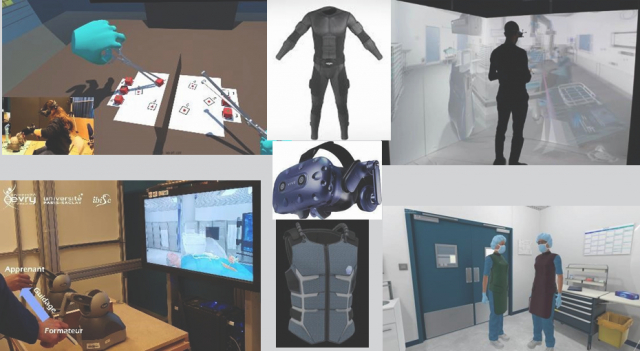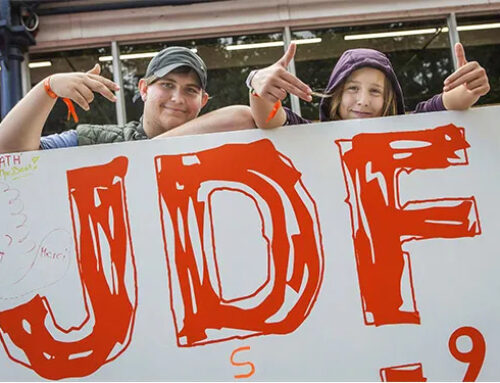Mots clefs Réalité Virtuelle, Interactions multimodales, Interactions collaboratives, Interactions haptiques, formation par compagnonnage, formation professionnelle
Nous recherchons une personne (H/F) enthousiaste et fortement motivée pour aider à repousser les limites des connaissances et de la technologie dans les domaines de l’interaction humain-machine et de la réalité virtuelle appliqués à la formation professionnelle, notamment dans le domaine de la santé.
Les candidats doivent avoir de l’expérience dans la conception et l’évaluation des systèmes interactifs en réalité virtuelle immersive. Ils doivent avoir de bonnes compétences en communication, la capacité de travailler efficacement au sein d’équipes multidisciplinaires, faire preuve d’un haut niveau d’initiative et avoir la capacité de mener à bien tous les aspects du processus de recherche.
La personne recrutée sera intégrée au sein de l’équipe de recherche IRA2 du laboratoire IBISC. Il/elle sera impliqué.e dans la réalisation d’un projet de recherche financé par l’ANR et le co-encadrement de doctorants/stagiaires. Il/elle rejoindra une équipe très dynamique et avec une bonne ambiance de travail.
Projet de recherche associé
Le projet ANR Show-me (2021-2025) vise à concevoir et développer des interfaces et techniques d’interaction permettant à un formateur d’interagir et de partager ses compétences avec un apprenant au sein d’un environnement virtuel immersif. Les travaux sont appliqués au domaine de la formation des opérateurs en anesthésie locorégionale échoguidée. Pour plus d’information : https://anr.fr/Project–ANR–20–CE33–0010
Responsabilités de la personne recrutée
- Réaliser des études de l’état de l’art et de veille technologique en lien avec le projet,
- Participer à l’encadrement d’un doctorant et des stagiaires de l’équipe participants au projet,
- Concevoir et développer des prototypes d’environnements virtuels pour illustrer les concepts étudiés,
- Participer à la mise en place de protocoles d’évaluation des prototypes et l’analyse des données expérimentales,
- Réaliser des tâches de gestion de projet (planning, rédaction de rapports techniques, participation aux réunions du projet…),
- Participer à la diffusion des résultats dans des revues et conférences internationales réputées (ex. IEEE VR, IEEE ISMAR, Frontiers in Virtual Reality…), et dans les événements professionnels et grand public (démos au sein de la plateforme EVR@, salons professionnels…).
Compétences et qualités requises
- Avoir un doctorat en Interaction humain-machine/réalité virtuelle,
- Excellente maîtrise des outils de développement pour la réalité virtuelle (Unity 3D/C#, Unreal Engine/C++) et des dispositifs d’interaction (interfaces haptiques, casques de RV…),
- Connaissance des interactions 3D, de la méthodologie de conception centrée utilisateur,
- Maitrise de la mise en place des protocoles expérimentaux et des méthodes statistiques pour l’analyse des données,
- Avoir un goût pour la recherche et les échanges pluridisciplinaires,
- Savoir travailler en autonomie et en équipe,
- Savoir hiérarchiser les tâches, manager les membres d’une équipe (doctorants, stagiaires) et restituer les résultats en respectant les délais.
Conditions de travail
Les travaux de recherche seront réalisés au laboratoire IBISC. L’encadrement des travaux sera assuré par Amine CHELLALI et les membres de son équipe. Une plateforme expérimentale (plateforme EVR@) et des environnements virtuels pour la simulation sont mis à disposition (Figure 1). Le candidat sera en interaction avec les doctorants et stagiaires de l’équipe. Il/elle sera également convié.e à participer aux réunions d’avancement du projet. Durée : 18 mois
Date de début : immédiatement
Salaire : À partir de 2200€ net (selon expérience)
Figure 1: Exemples des simulations et technologies présentes sur la plateforme EVR@ (CAVE, casques, systèmes de eye tracking, gants de données, bras à retour d’efforts, écrans tactiles, vestes haptiques…) /Examples of simulations and technologies of the EVR@ platform (CAVE, HMDs, eye tracking systems, data gloves, haptic devices, touch screens, haptic suits)
Virtual reality postdoc/research engineer offer
Keywords: Virtual Reality, Multimodal interactions, Collaborative interactions, Haptic interactions, mentorship training, Professional training
We are seeking for an enthusiastic and highly motivated person (M/F) to help push the boundaries of knowledge and technology in the fields of HCI and virtual reality applied to professional education and training in healthcare. Candidates should have experience in the design and evaluation of interactive systems in immersive virtual reality. They should have good communication skills, the ability to work effectively in multidisciplinary teams, demonstrate a high level of initiative, and have the ability to carry out all aspects of the research process. The recruited person will be part of the IRA2 research group of the IBISC laboratory. He/she will be involved in the realization of a research project funded by the ANR and the co-supervision of a Ph.D. student/interns. He/she will join a very dynamic team with a good working atmosphere.
Related research project
The Show-me ANR project (2021-2025) aims to design and develop interfaces and interaction techniques allowing an expert to interact and share his/her skills with a learner within a shared immersive virtual environment. The work is applied to train operators in ultrasound-guided locoregional anesthesia. For more information: https://anr.fr/Project–ANR–20–CE33–0010
Responsibilities of the recruited person
- Carrying out literature reviews and technology watch in connection with the project,
- Participating in the supervision of a Ph.D. student and interns participating in the project,
- Designing and developing prototypes of virtual environments to illustrate the studied concepts,
- Participating in the design of evaluation protocols and the analysis of experimental data,
- Carrying out project management tasks (planning, drafting of technical reports, participation in project meetings, etc.),
- Participating in the dissemination of results in top-tier international journals and conferences (eg. IEEE VR, IEEE ISMAR, Frontiers in Virtual Reality, etc.), and in professional and general public events (demos within the EVR@ platform, trade fairs, etc.).
Required skills and qualities
- Have a Ph.D. in Human-Computer Interaction, Virtual Reality, or related fields,
- Excellent knowledge of development tools for virtual reality (Unity 3D/C#, Unreal Engine/C++) and interaction devices (haptic interfaces, VR headsets, etc.),
- Knowledge of 3D interaction design, user-centered design methodology,
- Ability to implement experimental protocols and knowledge in statistical methods for data analysis,
- Have a taste for research and multidisciplinary exchanges,
- Ability to work independently and in a team,
- Know how to prioritize tasks, manage team members (Ph.D. students, interns), and report results in a timely manner.
Work conditions
The research work will be carried out at the IBISC laboratory. Supervision of the work will be provided by Amine CHELLALI and the members of his team. An experimental platform (EVR@ platform) and virtual environments for simulation are provided (Figure 1). The candidate will interact with the Ph.D. students and interns of the team. He/she will also be invited to participate in the progress meetings of the project. Duration: 18 months
Start date: Immediately
Net salary: From 2200€ (depending on experience)
Information de contact/contact information
Merci de faire parvenir une lettre de motivation, un CV, et une lettre de recommandation recherche à :
Please send your application letter, a CV, and a research recommendation letter to:
| Amine CHELLALI | Laboratoire IBISC EA 4526 – Université Paris Saclay (Campus Evry)
Bâtiment Pelvoux 2, IUP 40, Rue du Pelvoux Courcouronnes 91020 EVRY |
References
- Chellali A, Mentis H, Miller A, Ahn W, Arikatla V, Sankaranarayanan G, Schwaitzberg S, Cao C (2016) Achieving Interface and Environment Fidelity in the Virtual Basic Laparoscopic Surgical Trainer. IJHCS 96: 22–37 [HAL IBISC]
- Chellali A, Dumas C, Milleville-Pennel I (2012) Haptic communication to support biopsy procedures learning in virtual environments. Presence: Teleoperators and Virtual Environments 21(4): 470–489
- Mentis H, Chellali A, Schwaitzberg S (2014) Learning to see the body: supporting instructional practices in laparoscopic surgical procedures. Proceedings of the CHI Conference on Human Factors in Computing Systems, pp 2113–2122
- Mentis HM, Feng Y, Semsar A, Ponsky TA (2020) Remotely Shaping the View in Surgical Telementoring. Proceedings of the CHI Conference on Human Factors in Computing Systems, pp 1–14
- Le Chénéchal M, Duval T, Gouranton V, Royan J, Arnaldi B (2019) Help! I Need a Remote Guide in My Mixed Reality Collaborative Environment. Frontiers in Robotics and AI 6: 106
- Chengyuan, Edgar, Maria, et al. (2020) How About the Mentor? Effective Workspace Visualization in AR Telementoring. 2020 IEEE Conference on Virtual Reality and 3D User Interfaces (VR)
- Lee G, Kang H, Lee J, Han J (2020) A User Study on View-sharing Techniques for One-to-Many Mixed Reality Collaborations. 2020 IEEE Conference on Virtual Reality and 3D User Interfaces (VR)
- Moll J, Frid E (2017) Using eye-tracking to study the effect of haptic feedback on visual focus during collaborative object managing in a multimodal virtual interface. SweCog 2017, October 26–27, Uppsala, Sweden, pp 49–51
- Moll J, Pysander ELS, Eklundh KS, Hellström SO (2014) The effects of audio and haptic feedback on collaborative scanning and placing. Interacting with computers 26: 177–195
- Wang J, Chellali A, Cao CGL (2016) Haptic communication in collaborative virtual environments. Human factors 58: 496–508
- Ricca, A. Chellali, A., Otmane, S. (2020) Influence of hand visualization on tool-based motor skills training in an immersive VR simulator. In the proceedings of IEEE International Symposium on Mixed and Augmented Reality (ISMAR), pp 339-347. [HAL IBISC]
- Ricca A, Chellali A, Otmane S (2021) Comparing touch-based and head-tracking navigation techniques in a virtual reality biopsy simulator. Virtual Reality, 25, pages 191–208. [HAL IBISC]
- Gamelin, G.,Chellali, A., Cheikh, S., Ricca, A., Dumas, C., Otmane, S. (2021) Point-cloud avatars to improve spatial communication in immersive collaborative virtual environments, Personal and Ubiquitous Computing, 25, 467–484. [HAL IBISC]
- Ricca, A. Chellali, A., Otmane, S. (2021) The influence of hand visualization in tool-based motor-skills training, a longitudinal study. In the proceedings of IEEE Virtual Reality and 3D User Interfaces 2021 Conference (IEEE VR), 103-112. [HAL IBISC]
- Fastelli, F., Simon, C., Ricca, A., & Chellali, A. (2022). Study of communication modalities for teaching distance information. In 2022 IEEE Conference on Virtual Reality and 3D User Interfaces Abstracts and Workshops (VRW) (pp. 706-707). [HAL IBISC]
- Simon, C., Herfort, L., & Chellali, A. (2022). Design and evaluation of an immersive ultrasound-guided locoregional anesthesia simulator. In 2022 IEEE Conference on Virtual Reality and 3D User Interfaces Abstracts and Workshops (VRW) (pp. 445-449). [HAL IBISC]
- Simon, C. Otmane, S., Chellali, A. (2022) Comparing Modalities to Communicate Movement Amplitude During Tool Manipulation in a Shared Learning Virtual Environment. In the proceedings of ICAT-EGVE 2022, pp. 1-10 [HAL IBISC]
- Date de l’appel : 16/02/2023
- Statut de l’appel : Pourvu
- Contact coté IBISC : Amine CHELLALI (MCF Univ. Évry, IBISC équipe IRA2)
- Poste en CDD ingénieur de recherche en Réalité Virtuelle (format PDF)
- Web équipe IRA2






